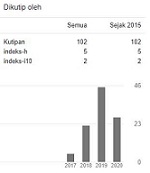THE CORRELATION OF STUDENTS’ INTRINSIC MOTIVATION TOWARD READING COMPREHENSION OF THE SEVENTH GRADE SMP AL-MAARIF PANGGUNG
Abstract
Keywords
References
Adamson, K. A. & Prion, S. (2013). Reliability : measuring internal consistency using cronbach’s, Clinical Simulation in Nursing, 9, hlm. 179-180
Alderson, C. J. 2000. Assessing Reading. Cambridge: Cambridge University Press.
Anderson, R. C., & Pearson, P. D. (1984). A schema-theoretic view of basic processes in reading. In P. D. Pearson, R.Barr, M. L. Kamil, & P. Mosenthal (Eds.), Handbook of reading research (pp. 255–292). New York: Longman.Retrieved fromhttp://hdl.handle.net/2142/31284.
Arthur W. Heilman, et al., Principles and Practices of Teaching Reading Fifth Edition, p. 246.
Brown, H.D. 2004. Language Assesment: Principles and Classroom Practices. NewYork: Pearson Education
Durkin, D. (1993). Teaching them to read (6th Ed.). Boston: Allyn & Bacon.
Harmer, Jeremy. 2007. The Practice of English Language Teaching. England: Pearson Education Limited
Kruidenier, John. Research-Based Principles for Adult Basic Education Reading Instruction. USA, The National Institute for Literacy, 2002), p. 77.
Lile, W. T. 2002. Motivation In ELS Classroom. The Internet TESL Journal/8(1). Retrieved from http://iteslj.org/Techiques/Lile-Motivation.
Malone, T.W., & Lepper, M.R. (1987). Making learning fun: A taxonomy of intrinsic motivation for learning. In R.E. Snow & M.J Farr (Eds.), Aptitude, learning, and instruction valume 3: Connactive and affective process analyses (pp. 223-2453). Hillsdale, NJ: Lawrence Erlbaum Associates, Publisher.
Plani, k.k. (2012). Promoting reading habit and creating literate socity. Journal of Art & Commerce, 2(1), 91-94.
Serravallo, Jennifer. Teaching Reading in Small Group. (USA, Heinemann, 2010), p. 43.
Sugiono, 2011. Metode Penelitian Kuantitatif, Kualitatif, dan R&D. Bandung: Afabeta, cv.
Sari, E.R. 2017. The Correlation Study Between Students’motivation And Reading Comprehension Of The Fourth Semester Students Of The State Islamic Institute Of Surakarta In The Academic Year Of 2015/2016. Thesis. Surakarta. English Education Study Program Islamic Education And Teacher Training Faculty. Islamic Institute of Surakart.
Usher, A. (2012). What is motivation and why does it matter? Washington, D.C.: Center on Education Policy.
Wixson, K., Peters, C., Weber, E., &Roeber, I. (1987).New directions in statewide reading assessment. The Reading Teacher, 40(8), 749-
DOI: 10.53712/ellite.v4i1.1035
Refbacks
- There are currently no refbacks.







